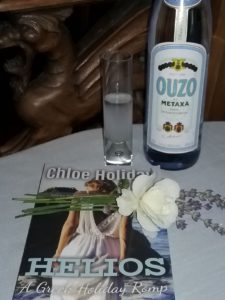 Ouzo (OOH-zo) is an anise-flavored clear liquor which is featured in Helios and the other novels in this series. The home-brewed raki similarly tastes like licorice. Its origins, like those of many alcoholic beverages, trace back to monasteries—holy spirits, indeed!
Ouzo (OOH-zo) is an anise-flavored clear liquor which is featured in Helios and the other novels in this series. The home-brewed raki similarly tastes like licorice. Its origins, like those of many alcoholic beverages, trace back to monasteries—holy spirits, indeed!
The word ouzo most likely comes from the Turkish word for grape, üzüm, though there are stories which relay that the Greek consulate, after sampling a particularly nice batch, exclaimed, “uso Massalia”—Italian for “to be used in Marseille.” Those words were stamped on crates containing the highest-grade silkworm cocoons back then, so this meant “only the finest.” Ouzo rose in popularity as absinthe fell from grace. Ouzo is now a protected term that can only be used by Greek distillers; in this way it is similar to French Champagne—in the U.S. similar products can’t use the Champagne label, but instead are called “sparkling wine.”
Ouzo production begins with distilled ethanol, 96% alcohol by volume (ABV) which is then mixed with anise and other flavorings; each distillery has their own closely guarded recipe. Though this mixture is called “ouzo yeast,” no actual fermentation is involved in the making of ouzo. After further distillation, the ouzo yeast is cut with ethyl alcohol or water dilution, bringing the final ABV to 37.5 to 50 percent.
In Greece, ouzeries serve ouzo and appetizers called mezedes: calamari, olives, octopus, sardines, zucchini, etc. Because ouzo is strong and sweet (some producers add sugar), it’s easy to overindulge and become tipsy. Food slows the absorption of alcohol, and presumably slows down the drinker as well. It’s considered bad manners to drink it “dry hammer,” on an empty stomach—something Konstantinos mentions during the flight.
If you look at the picture above, you’ll see the ouzo in the bottle is clear, yet that in the glass is cloudy. What gives? Anethole, the essential oil of anise, is completely soluble in alcohol at approximately 38% ABV and above, but not in water. Since ouzo is drunk over ice or diluted with water, the essential oil separates, creating an emulsion in a process is called louching. The fine droplets scatter the light, causing the cloudy, milky look of the ouzo in the glass.
What does ouzo taste like? It’s got an intense licorice taste, with an underlying alcohol kick, strong enough to contribute to any number of bad choices by the unwary.
More on bad choices next week!

Recent Comments